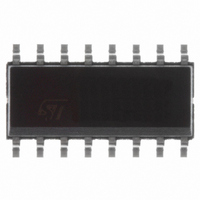L6566A STMicroelectronics, L6566A Datasheet - Page 22

L6566A
Manufacturer Part Number
L6566A
Description
IC CTRLR OVP UVLO 16SOIC
Manufacturer
STMicroelectronics
Datasheet
1.L6566ATR.pdf
(51 pages)
Specifications of L6566A
Output Isolation
Isolated
Frequency Range
93 ~ 107kHz
Voltage - Input
8 ~ 23 V
Power (watts)
750mW
Operating Temperature
-40°C ~ 150°C
Package / Case
16-SOIC (0.154", 3.90mm Width)
Output Current
800 mA
Output Power
750 mW
Input Voltage
8 V to 23 V
Operating Temperature Range
- 40 C to + 150 C
Mounting Style
SMD/SMT
Duty Cycle (max)
75 %
Universal Input Mains Range
90÷264Vac - Frequency 45 ÷ 65 Hz
Output Voltage
19 V@4 A continuous operation
Mains Harmonics
Acc. to EN61000-3-2 Class-D
St-by Mains Consumption
Less than 0.25 W @265Vac
Overall Efficiency
Better than 86%
Emi
According to EN55022-Class-B
Safety
According to EN60950
Low Profile Design
25 mm maximum height
Pcb Single Layer
single side, 70 μm, CEM-1, 78x174 mm, Mixed PTH/SMT
For Use With
497-8834 - BOARD DEMO FOR L6563/LL6566A497-6452 - BOARD EVAL FOR L6566B497-6451 - BOARD EVAL FOR L6566B497-6450 - BOARD EVAL FOR L6566B497-6449 - BOARD EVAL FOR L6566A
Lead Free Status / RoHS Status
Lead free / RoHS Compliant
Available stocks
Company
Part Number
Manufacturer
Quantity
Price
Company:
Part Number:
L6566A
Manufacturer:
NXP
Quantity:
10 000
Part Number:
L6566A
Manufacturer:
ST
Quantity:
20 000
Part Number:
L6566ATR
Manufacturer:
ST
Quantity:
20 000
Application information
Note:
22/51
When the system operates in valley skipping-mode, uneven switching cycles may be
observed under some line/load conditions, due to the fact that the OFF-time of the MOSFET
is allowed to change with discrete steps of one ringing cycle, while the OFF-time needed for
cycle-by-cycle energy balance may fall in between. Thus one or more longer switching
cycles will be compensated by one or more shorter cycles and vice versa. However, this
mechanism is absolutely normal and there is no appreciable effect on the performance of
the converter or on its output voltage.
If the MOSFET is enabled to turn on but the amplitude of the signal on the ZCD pin is
smaller than the arming threshold for some reason (e.g. a heavy damping of drain
oscillations, like in some single-stage PFC topologies, or when a turn-off snubber is used),
MOSFET’s turn-on cannot be triggered. This case is identical to what happens at start-up:
at the end of the next oscillator cycle the MOSFET will be turned on, and a new switching
cycle will take place after skipping no more than one oscillator cycle.
The operation described so far does not consider the blanking time T
turn off, and actually T
met:
Equation 3
where D is the MOSFET duty cycle. If this condition is not met, things do not change
substantially: the time during which MOSFET’s turn-on is inhibited is extended beyond T
by a fraction of T
lower than the programmed value f
earlier than expected. However this is quite unusual: setting f
phenomenon can be observed at duty cycles higher than 60 %. See
block on page 35
If the voltage on the COMP pin (9) saturates high, which reveals an open control loop, an
internal pull-up keeps the ZCD pin close to 2 V during MOSFET's OFF-time to prevent noise
from false triggering the detection block. When this pull-up is active, the ZCD pin might not
be able to go below the triggering threshold, which would stop the converter. To allow auto-
restart operation, however ensuring minimum operating frequency in these conditions, the
oscillator frequency that retriggers MOSFET's turn-on is that of the external oscillator
divided by 128. Additionally, to prevent malfunction at converter's start-up, the pull-up is
disabled during the initial soft-start (see the relevant section). However, to ensure a correct
start-up, at the end of the soft-start phase the output voltage of the converter must meet the
condition:
Equation 4
where Ns is the turn number of the secondary winding, Naux the turn number of the
auxiliary winding and I
BLANK
for further implications of T
BLANK
ZCD
. As a consequence, the maximum switching frequency will be a little
the maximum pull-up current (130 μ A).
does not come into play as long as the following condition is
osc
Vout >
and valley-skipping mode may take place slightly
D
≤
1
Naux
−
Ns
BLANK
T
BLANK
T
osc
R
Z
.
1
I
ZCD
osc
= 150 kHz, the
BLANK
Section 5.11: OVP
after MOSFET’s
L6566A
osc













